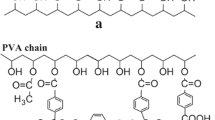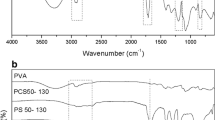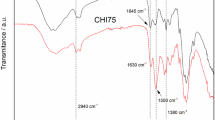Abstract
The reinforcement effect of microfibrillated cellulose (MFC) in high-density polyethylene (HDPE) was investigated by mechanical, thermal, and rheological analysis. The reinforcement effect using both maleic-anhydride-grafted polypropylene (MAPP) and cationic polymer using primary amine (CPPA) as coupling agents in MFC-reinforced polypropylene (PP) has been reported in our previous study (Suzuki et al. in Cellulose 21:507–518, 2014. doi:10.1007/s10570-013-0143-9). The combined use of MAPP and CPPA showed a greater reinforcement effect in the MFC-reinforced HDPE composite than in MFC-reinforced PP. The tensile modulus of MFC-reinforced HDPE was about 22 % higher than that of MFC-reinforced PP. Rheological analysis showed that there was a drastic improvement in the interaction between MFC and HDPE using CPPA and MAPP. The storage modulus of the MFC/HDPE composite in the melt state using MAPP and CPPA as coupling reagents was about three times higher than that without the coupling reagents. Furthermore, differential scanning calorimetry analysis suggested that a chemical reaction occurred between MAPP and CPPA. In addition, the thermal properties of MFC-reinforced HDPE were remarkably improved using MAPP and CPPA: the coefficient of thermal expansion of the composite decreased from 237.2 (HDPE) to 57.1 ppm/K (MFC/HDPE/MAPP/CPPA) and the heat distortion temperature under 0.45 MPa load improved from 67.4 (HDPE) to 116.7 °C (MFC/HDPE/MAPP/CPPA).









Similar content being viewed by others
References
Achilias DS, Roupakias C, Megalokonomos P, Lappas AA, Antonakou EV (2007) Chemical recycling of plastic wastes made from polyethylene (LDPE and HDPE) and polypropylene (PP). J Hazard Mater 149(3):536–542. doi:10.1016/j.jhazmat.2007.06.076
Aitomäki Y, Oksman K (2014) Reinforcing efficiency of nanocellulose in polymers. React Funct Polym 85:151–156. doi:10.1016/j.reactfunctpolym.2014.08.010
Bettaieb F, Nechyporchuk O, Khiari R, Mhennia MF, Dufresne A, Belgacem MN (2015) Effect of the oxidation treatment on the production of cellulose nanofiber suspensions from Posidonia oceanica: the rheological aspect. Carbohydr Polym 134:664–672. doi:10.1016/j.carbpol.2015.07.091
Blaker JJ, Lee K, Bismarck A (2011) Hierarchical composites made entirely from renewable resources. J Biobased Mater Bioenergy 5:1–16. doi:10.1166/jbmb.2011.1113
Brandrup J, Immergut EH, Grulke EA (2003) Polymer handbook, 4th edn. Wiley
Dufresne A, Bras J, Siqueira G (2010) Cellulosic bionanocomposites: a review of preparation, properties and applications. Polymers 2:728–765. doi:10.3390/polym2040728
Eichhorn SJ, Dufresne A, Aranguren M, Marcovich NE, Capadona JR, Rowan SJ, Weder C, Thielemans W, Roman M, Renneckar S, Gindl W, Veigel S, Keckes J, Yano H, Abe K, Nogi M, Nakagaito AN, Mangalam A, Simonsen J, Benight AS, Bismarck A, Berglund LA, Peijs T (2010) Review: current international research into cellulose nanofibres and nanocomposites. J Mater Sci 45(1):1–33. doi:10.1007/s10853-009-3874-0
Gurunathan T, Mohanty S, Nayak SK (2015) A review of the recent developments in biocomposites based on natural fibres and their application perspectives. Compos Part A Appl Sci 77:1–25. doi:10.1016/j.compositesa.2015.06.007
Ho TTT, Abe K, Zimmermann T, Yano H (2015) Nanofibrillation of pulp fibers by twin-screw extrusion. Cellulose 22:421–433. doi:10.1007/s10570-014-0518-6
Hubbe MA, Rojas OJ, Lucia LA, Sain M (2008) Cellulosic nanocomposites: a review. BioResources 3(3):929–980
Iwamoto S, Abe K, Yano H (2008) The effect of hemicelluloses on wood pulp nanofibrillation and nanofiber network characteristics. Biomacromolecules 9:1022–1026. doi:10.1021/bm701157n
Iwamoto S, Lee SH, Endo T (2014) Relationship between aspect ratio and suspension viscosity of wood cellulose nanofibers. Polym J 46:73–76. doi:10.1038/pj.2013.64
Iwatake A, Nogi M, Yano H (2008) Cellulose nanofiber-reinforced polylactic acid. Compos Sci Technol 68(9):2103–2106. doi:10.1016/j.compscitech.2008.03.006
Jonoobi M, Harun J, Mathew AP, Oksman K (2010) Mechanical properties of cellulose nanofiber (CNF) reinforced polylactic acid (PLA) prepared by twin screw extrusion. Compos Sci Technol 70(12):1742–1747. doi:10.1016/j.compscitech.2010.07.00
Jonoobi M, Oladi R, Davoudpour Y, Oksman K, Dufresne A, Hamzeh Y, Davoodi R (2015) Different preparation methods and properties of nanostructured cellulose from various natural resources and residues: a review. Cellulose 22:935–969. doi:10.1007/S10570-015-0551-0
Klemm D, Heublein B, Fink H, Bohn A (2005) Cellulose: fascinating biopolymer and sustainable raw material. Angew Chem Int Ed 44:2293–3358. doi:10.1002/anie.200460587
Klemm D, Kramer F, Moritz S, Lindström T, Ankerfors M, Gray D, Dorris A (2011) Nanocelluloses: a new family of nature-based materials. Angew Chem Int Ed 50(24):5438–5466. doi:10.1002/anie.201001273
Lee K, Aitomäki Y, Berglund LA, Oksman K, Bismarck A (2014) On the use of nanocellulose as reinforcement in polymer matrix composites. Compos Sci Technol 105:15–27. doi:10.1016/j.compscitech.2014.08.032
Lindström T, Aulin C (2014) Market and technical challenges and opportunities in the area of innovative new materials and composites based on nanocellulosics. Scand J For Res 29(4):345–351. doi:10.1080/02827581.2014.928365
Ljungberg N, Cavaillé J-Y, Heux L (2005) New nanocomposites materials reinforced with cellulose whiskers in atactic polypropylene: effect of surface and dispersion characteristics. Biomacromolecules 6(5):2732–2739. doi:10.1021/bm050222v
Mabrouk AB, Kaddami H, Boufi S, Erchiqui F, Dufresne A (2012) Cellulosic nanoparticles from alfa fibers (Stipa tenacissima): extraction procedures and reinforcement potential in polymer nanocomposites. Cellulose 19(3):843–853. doi:10.1007/s10570-012-9662-z
Menezes AJ, Siqueira G, Curvelo AAS, Dufresne A (2009) Extrusion and characterization of functionalized cellulose whiskers reinforced polyethylene nanocomposites. Polymer 50:4552–4563. doi:10.1016/j.polymer.2009.07.038
Miao C, Hamad WY (2013) Cellulose reinforced polymer composites and nanocomposites: a critical review. Cellulose 20(5):2221–2262. doi:10.1007/s10570-013-0007-3
Moon RJ, Martini A, Nairn J, Simonsen J, Youngblood J (2011) Cellulose nanomaterials review: structure, properties and nanocomposites. Chem Soc Rev 40:3941–3994. doi:10.1039/C0CS00108B
Nakagaito AN, Yano H (2008) The effect of fiber content on the mechanical and thermal expansion properties of biocomposites based on microfibrillated cellulose. Cellulose 15:555–559. doi:10.1007/s10570-008-9212-x
Nishino T, Matsuda I, Hirao K (2004) All-cellulose composite. Macromolecules 37(20):7683–7687. doi:10.1021/ma049300h
Okahisa Y, Yoshida A, Miyaguchi S, Yano H (2009) Optically transparent wood–cellulose nanocomposite as a base substrate for flexible organic light-emitting diode displays. Compos Sci Technol 69:1958–1961. doi:10.1016/j.compscitech.2009.04.017
Page DH, El-Hosseiny F (1983) The mechanical properties of single wood pulp fibres. J Pulp Pap Sci 9:99–100
Peacock A (2000) Handbook of polyethylene. CRC Press, Boca Raton, p 16
Rowell RM (2007) Challenges in biomass—thermoplastics composites. J Polym Environ 15:229–235
Sadatoshi H, Suzuki H, Miyake Y, Nomura T, Nishio T (1998) Thermoplastic resin composition. US Patent 5,852,100
Sakurada I, Nukushina Y, Ito T (1962) Experimental determination of the elastic modulus of crystalline regions in oriented polymers. J Polym Sci 57(165):651–660
Samir MAS, Alloin F, Dufresne A (2005) Review of recent research into cellulosic whiskers, their properties and their application in nanocomposite field. Biomacromolecules 6(2):612–626. doi:10.1021/bm0493685
Sdrobiş A, Darie RN, Totolin M, Cazacu G, Vasile C (2012) Low density polyethylene composites containing cellulose pulp fibers. Compos Part B Eng 43(4):1873–1880. doi:10.1016/j.compositesb.2012.01.064
Siró I, Plackett D (2010) Microfibrillated cellulose and new nanocomposite materials: a review. Cellulose 17(3):459–494. doi:10.1007/s10570-010-9405-y
Suzuki K, Okumura H, Kitagawa K, Sato S, Nakagaito AN, Yano H (2013) Development of continuous process enabling nanofibrillation of pulp and melt compounding. Cellulose 20(1):201–210. doi:10.1007/s10570-012-9843-931
Suzuki K, Sato A, Okumura H, Hashimoto T, Nakagaito AN, Yano H (2014) Novel high-strength, micro fibrillated cellulose-reinforced polypropylene composites using a cationic polymer as compatibilizer. Cellulose 21(1):507–518. doi:10.1007/s10570-013-0143-9
Taheri H, Samyn P (2015) Rheological properties and processing of polymer blends with micro- and nano-fibrillated cellulose. Agric Biomass Based Potential Mater. doi:10.1007/978-3-319-13847-3_13
Tatsumi D, Ishioka S, Matsumoto T (2002) Effect of fiber concentration and axial ratio on the rheological properties of cellulose fiber suspensions. J Soc Rheol Jpn 30(1):27–32. doi:10.1678/rheology.30.27
Acknowledgments
We thank Dr. Antonio Norio Nakagaito, University of Tokushima, for advice concerning this research. This study was supported by the Industrial Technology Research Grant Program of the New Energy and Industrial Technology Development Organization (NEDO), Japan, Oji Holdings Corporation, Mitsubishi Chemical Corporation, DIC Corporation, Seiko PMC Corporation, Nippon Paper Industries Co., Ltd., and Sumitomo Rubber Industries.
Author information
Authors and Affiliations
Corresponding author
Rights and permissions
About this article
Cite this article
Suzuki, K., Homma, Y., Igarashi, Y. et al. Investigation of the mechanism and effectiveness of cationic polymer as a compatibilizer in microfibrillated cellulose-reinforced polyolefins. Cellulose 23, 623–635 (2016). https://doi.org/10.1007/s10570-015-0845-2
Received:
Accepted:
Published:
Issue Date:
DOI: https://doi.org/10.1007/s10570-015-0845-2




